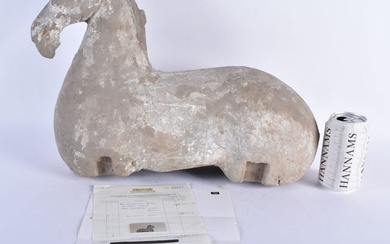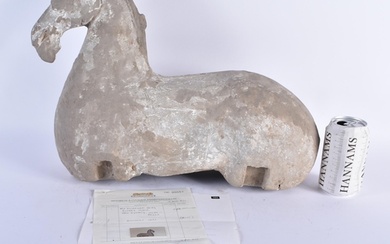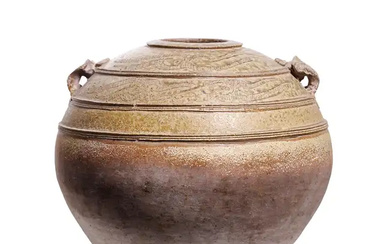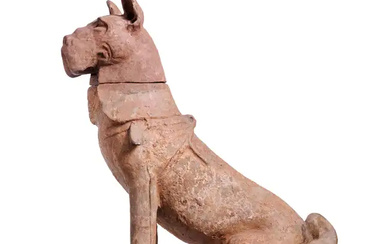A CHINESE HAN DYNASTY LARGE RITUAL BRONZE WINE VASE, HU
A CHINESE HAN DYNASTY LARGE RITUAL BRONZE WINE VASE, HU
China, Han dynasty
Of imposing size, the vase lays on a circular base, the globular body surmounted by a circular section neck with a gradually widening diameter until it reaches maximum dimensions near the mouth, a series of horizontal parallel straps on the shoulders with two animal masks with a ring between the jaws (pushou), to the shoulder a four characters inscription.
47 cm high
Provenance : Fabrizio Savi collection, acquired by Anthony J. Allen, Auckland, New Zealand, between 1995 and 2000.
The characteristic hu shape - circular base, pyriform body and cylindrical neck - is in the repertoire of Chinese bronze from the late Shang period, and evolved constantly in the following centuries until finally settling in the Han dynasty, during which the vessel walls became thinner and the decoration practically disappeared, except for the frequent presence of animal masks with mobile rings.
According to Yili ("The book of rituals and ceremonies"), a classic of Chinese literature in which the official etiquette followed during the Zhou dynasty is explained, the hu vases were used to contain alcoholic beverages. However, according to other ancient texts and based on inscriptions on some vases of this type, they could also contain water.
Sale price
Estimate
Time, Location
Auction House
A CHINESE HAN DYNASTY LARGE RITUAL BRONZE WINE VASE, HU
China, Han dynasty
Of imposing size, the vase lays on a circular base, the globular body surmounted by a circular section neck with a gradually widening diameter until it reaches maximum dimensions near the mouth, a series of horizontal parallel straps on the shoulders with two animal masks with a ring between the jaws (pushou), to the shoulder a four characters inscription.
47 cm high
Provenance : Fabrizio Savi collection, acquired by Anthony J. Allen, Auckland, New Zealand, between 1995 and 2000.
The characteristic hu shape - circular base, pyriform body and cylindrical neck - is in the repertoire of Chinese bronze from the late Shang period, and evolved constantly in the following centuries until finally settling in the Han dynasty, during which the vessel walls became thinner and the decoration practically disappeared, except for the frequent presence of animal masks with mobile rings.
According to Yili ("The book of rituals and ceremonies"), a classic of Chinese literature in which the official etiquette followed during the Zhou dynasty is explained, the hu vases were used to contain alcoholic beverages. However, according to other ancient texts and based on inscriptions on some vases of this type, they could also contain water.







